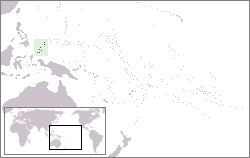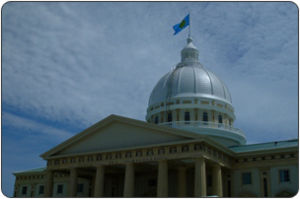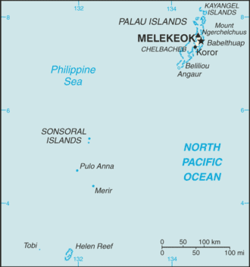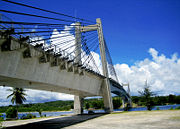Palau
2008/9 Schools Wikipedia Selection. Related subjects: Geography of Oceania (Australasia)
| Beluu er a Belau Republic of Palau
|
||||||
|---|---|---|---|---|---|---|
|
||||||
| Anthem: Belau loba klisiich er a kelulul |
||||||
|
|
||||||
| Capital | Melekeok1 |
|||||
| Largest city | Koror | |||||
| Official languages | English, Palauan, | |||||
| Recognised regional languages | Japanese, Angaur, (in Angaur) Sonsorolese, (in Sonsoral) Tobian, (in Hatohobei), Carolinian, Filipino, Chinese | |||||
| Demonym | Palauan | |||||
| Government | Democratic Presidential Republic | |||||
| - | President | Tommy Remengesau | ||||
| - | Vice president | Elias Camsek Chin | ||||
| Independence | from UN Trust Territory | |||||
| - | Date | October 1, 1994 | ||||
| Area | ||||||
| - | Total | 459 km² ( 195th) 177 sq mi |
||||
| - | Water (%) | negligible | ||||
| Population | ||||||
| - | July 2007 estimate | 20,842 ( 217th) | ||||
| - | Density | 43/km² ( 155th) 111/sq mi |
||||
| GDP ( PPP) | 2006 estimate | |||||
| - | Total | $157.7 million² ( not ranked) | ||||
| - | Per capita | $10,000 (2006 est.) ( not ranked) | ||||
| HDI (2003) | n/a (unranked) ( n/a) | |||||
| Currency | US Dollar ( USD) |
|||||
| Time zone | ( UTC+9) | |||||
| Internet TLD | .pw | |||||
| Calling code | +680 | |||||
| 1 On 7 October 2006, government officials moved their offices in the former capital of Koror to Melekeok, located 20 km (12 mi) northeast of Koror on Babelthaup Island. ² GDP estimate includes US subsidy (2004 est.) | ||||||
Palau (pronounced /pəˈlaʊ/), officially the Republic of Palau ( Palauan: Beluu er a Belau), is an island nation in the Pacific Ocean, some 500 miles (800 km) east of the Philippines and 2000 miles (3200 km) south of Tokyo. Having emerged from United Nations trusteeship (administered by the United States) in 1994, it is one of the world's youngest and smallest nations. It is sometimes referred to in English under its native name Belau.
History
Archaeology
Early Palauans may have come from Australia, Polynesia and Asia. Depending on the thread of the family, Palauans may indeed represent many parts of Melanesia, Micronesia and Polynesia. However, it is traditionally considered to be Micronesian. According to geneticists, there are two distinctive strains of Melanesian bloodlines: one is associated with indigenous Australians/Papua New Guineans and the other is known to have originated in Asia. There has not been any link established between the two.
Until recently, Palau was not considered a part of Micronesia. In the European and Australian world Belau/Pelew is better known by the name of " The Black Islands". Vintage maps and village drawings can be found at the Australian library online, as well as photos of the tattooed and pierced Ibedul of Koror and Ludee.
Carbon dating and recent archaeological discoveries have brought new attention to the archipelago. Cemeteries uncovered in islands have shown Palau has the oldest burial ceremony known to Oceania. Prior to this there has been much dispute as to whether Palau was established during 2500 BC or 1000 BC. New studies seem to dispute both of these findings. Moreover, Palau's ancient trading partner, Java, has also come under close scrutiny since Homo floresiensis was found. Like Flores remains of small-bodied humans have been found in Palau.
For thousands of years, Palauans have had a well established matrilineal society, believed to have descended from Javanese precedents. Traditionally, land, money, and titles passed through the female line. Clan lands continue to be passed through titled women and first daughters but there is also a modern patrilineal sentiment introduced by imperial Japan. The Japanese government attempted to confiscate and redistribute tribal land into personal ownership during World War II, and there has been little attempt to restore the old order. Legal entanglements continue amongst the various clans.
European contact
Historians take interest in the early navigational routes of European explorers in the Pacific. There is a certain controversy as to whether Spanish explorer Ruy López de Villalobos, who landed in several Caroline Islands, spotted the Palau archipielago in 1543. No conclusive evidence exists but there are some who think he could have seen the tip of a southernmost island in the group.
Palau had limited relations—mainly with Yap and Java. Had it not have been for ship-wrecked islanders who accidentally took refuge in the Philippines, Europeans likely would not have found a route to Palau until much later. English Captain Henry Wilson also shipwrecked off the island of Ulong in 1783. Wilson dubbed Palau the “Pelew Islands”.
Spanish rule
Like the Mariana Islands, the Caroline Islands and the Marshall Islands, Palau was part of the Spanish East Indies, and was administered from the Spanish Philippines until the Spanish-American War of 1898.
In 1885, after Germany occupied some of the islands, a dispute was brought to Pope Leo XIII, who made an attempt to legitimize the Spanish claim to the islands (but with economic concessions for Britain and Germany). Spain in 1899, after defeat during the Spanish-American War, sold the islands to Germany in the 1899 German-Spanish Treaty.
German Era
After the Spanish sold the islands to Germany, the Germans began an economic transformation in Micronesia. The Germans began mining bauxite (an aluminium ore), Phosphate, and other resources. The islands were also administered by German New Guinea. Mining continued throughout Micronesia even after the Germans lost the islands to Japan under the terms of the Treaty of Versailles, after World War I. The Japanese continued and expanded the mining operations.
Japanese rule
During World War I, under the terms of the Anglo-Japanese Alliance, the Empire of Japan declared war on the German Empire and invaded German overseas territories in the Pacific Ocean, including the Palau Islands. Following Germany's defeat, the League of Nations formally awarded Palau to Japan as a Class C League of Nations Mandate.
Under the terms of a “Class C Mandate” Japan incorporated the islands as an integral part of its empire, establishing the Nanyo-cho government. Initially under Imperial Japanese Navy administration, civilian control was introduced from 1922, and Palau was one of six administrative districts within the Mandate. Japan mounted an aggressive economic development program and promoted immigration by Japanese, Okinawans and Koreans. During this period, the Japanese established bonito (tuna production) and copra processing plants in Palau.
World War II
Peleliu was the scene of intense fighting between American and Japanese forces beginning September 1944 resulting in an Allied victory, though the cost in human terms was high for both sides. After WWII, the United Nations played a role in deciding the U.S. would administer Palau as part of the Trust Territory of the Pacific Islands. Eventually, in 1979, Palauans voted against joining the Federated States of Micronesia based on language and cultural differences. After a long period of transition, including the violent deaths of two presidents ( Haruo Remeliik in 1985 and Lazarus Salii in 1988), Palau voted to freely associate with the United States in 1994 while opting to retain independence under the Compact of Free Association.
There are still roughly 100 American service members listed as Missing In Action (MIA) in Palau since WWII. Since 1993, a small group of American volunteers called The BentProp Project have searched the waters and jungles of Palau to attempt to locate information that can lead to the identification and recovery of remains of these American MIAs.
Government
Politics of Palau takes place in a framework of a presidential representative democratic republic, whereby the President of Palau is both head of state and head of government, and of a multi-party system. Executive power is exercised by the government. Legislative power is vested in both the government and the Palau National Congress. The Judiciary is independent of the executive and the legislature.
Foreign relations
Palau gained its independence October 1, 1994, when the Compact of Free Association with the United States came into force. Palau was the last portion of the Trust Territory of the Pacific Islands to gain its independence. Under the Compact, the U.S. remains responsible for Palau's defense for 50 years, and Palauans are allowed to serve in the U.S. military without having to possess permanent residency in the U.S.
Palau is a sovereign nation and conducts its own foreign relations. Since independence, Palau has established diplomatic relations with a number of nations, including many of its Pacific neighbors. Palau was admitted to the United Nations on December 15, 1994, and has since joined several other international organizations. In September 2006, Palau hosted the first Taiwan-Pacific Allies Summit, and its President has gone on several official visits to other Pacific countries, including the Republic of China (Taiwan).
The United States maintains the usual diplomatic delegation and an embassy in Palau, but most aspects of the two countries' relationship have to do with Compact-funded projects, which are the responsibility of the U.S. Department of the Interior's Office of Insular Affairs. This has led to some ambiguity in the official status of Palau, though regarded as de jure independent.
Nuclear-free constitution
In 1981, Palau voted for the world's first nuclear-free constitution. However, this delayed Palau's independence as it also wanted a Compact of Free Association with the United States, which the U.S. would not agree to as long as the anti-nuclear clause was in place; thus the United Nations delayed terminating the U.S. trusteeship. Palauan independence was finally achieved after the anti-nuclear clause was repealed.
One of the notable aspects of the Palauan resistance to nuclear research is the leadership of women activists such as Cita Morei and Isabella Sumang.
Geography
Geography of Palau
Palau's most populated islands are Angaur, Babeldaob, Koror, and Peleliu. The latter three lie together within the same barrier reef, while Angaur is an Oceanic Island several miles to the South. About two-thirds of the population lives on Koror. The coral atoll of Kayangel is situated north of these islands, while the uninhabited Rock Islands (about 200) are situated to the west of the main island group. A remote group of six islands, known as the Southwest Islands, some 375 miles (600 km) from the main islands, are also part of the country and make up the States of Hatohobei and Sonsorol.
Climate
Palau enjoys a tropical climate all year round with an annual mean temperature of 82 ° F (27 ° C). Rainfall can occur throughout the year, averaging a total of 150 inches (3,800 mm). The average humidity over the course of the year is 82%, and although rain falls more frequently between July and October, there is still much sunshine. Typhoons are rare, as Palau is outside the main typhoon zone.
Environment
While much of Palau's natural environment remains free of environmental degradation, there are several areas of concern, including illegal fishing with the use of dynamite, inadequate facilities for disposal of solid waste in Koror, and extensive sand and coral dredging in the Palau lagoon. Like the other Pacific island nations, a potential major environmental threat is global warming and the related rising of sea level. Water coverage of low-lying areas is a threat to coastal vegetation, agriculture, and the purity of the nation's water supply. Palau also has a problem with inadequate water supply and limited agricultural areas to support the size of the population. The nation is also vulnerable to earthquakes, volcanic activity, and tropical storms. Sewage treatment is a problem, along with the handling of toxic waste from fertilizers and biocides.
On November 5, 2005, President of Palau Tommy E. Remengesau, Jr. took the lead on a regional environmental initiative called the Micronesia challenge, which would conserve 30 percent of near shore coastal waters and 20 percent of forest land by 2020. In addition to Palau, the initiative was joined by the Federated States of Micronesia and Marshall Islands, and the U.S. territories of Guam and Northern Mariana Islands. Together, this combined region represents nearly 5 percent of the marine area of the Pacific Ocean and 7 percent of its coastlines.
Economy
The economy consists primarily of tourism, subsistence agriculture, and fishing. Tourist activity focuses on scuba diving and snorkeling in the islands' rich marine environment, including the Floating Garden Islands to the west of Koror and the Rock Islands to the south. The government is the major employer of the work force, relying heavily on financial assistance from the US. Business and tourist arrivals numbered 50,000 in the financial year 2000/2001. The population enjoys a per capita income twice that of the Philippines and much of Micronesia. Long-term prospects for the key tourist sector have been greatly bolstered by the expansion of air travel in the Pacific, the rising prosperity of leading East Asian countries, and the willingness of foreigners to finance infrastructure development.
In July 2004, Palau Micronesia Air was launched with service from Palau to Yap, Guam, Micronesia, Saipan, Australia, and the Philippines. It was thought of giving Continental Micronesia a run for its money due to the low fares which it offered to its passengers, however it has ceased operations in December of the same year, mainly because the airline began operating at a time where fuel prices were skyrocketing and also because the cost of operation had been much more than anticipated. Palau Micronesia Air has not restarted operations since but has made a codeshare alliance with Asian Spirit, a carrier that operates flights between Palau and the Philippines ( Davao, Cebu, and Manila) and is much more affordable than Continental Micronesia. There are two flights weekly Manila via Cebu to Palau and one flight weekly from Davao. The flight costs $230 from Davao and $280 from Manila with one week advance booking. (Stand May 4. 2007)
Taxes are moderate, the income tax has 3 brackets with medium rates (9.3%, 15% and 19.6%), corporate tax is 14% and general sales tax is 7.5%. There are no property taxes.
Demographics
The population of Palau is approximately 21,000, of whom 70% are native Palauans, who are of mixed Melanesian, Micronesian, and Malayan descent. Filipinos form the second largest ethnic group. Other Asians and Europeans account for the minority groups.
Three quarters of the population are Christians (mainly Roman Catholics and Protestants), while Modekngei (a combination of Christianity, traditional Palauan religion and fortune telling) and the ancient Palauan religion are commonly observed. According to the 2005 census 49.4% of the population are Roman Catholics, 21.3% Protestants, 8.7% Modekngei and 5.3% Seventh-day Adventists.
The official languages of Palau are Palauan and English, except for two states (Sonsorol and Hatohobei) where the local language, along with Palauan, is official. Japanese is also spoken widely amongst older Palauans, and, indeed, retains official status in the State of Angaur. (It is to be noted that Kuniwo Nakamura, President of Palau 1993-2001, is himself of Japanese extraction). Tagalog is not official in Palau, but it is the 4th largest spoken language.
Transport
Palau International Airport provides scheduled direct flights to Guam, Taipei and Manila. In addition, the states of Angaur and Peleliu have regularly served airports.
Freight and cruise ships call at Malakal Harbour, on Malakal Island outside Koror.
The country has no railways, and almost half of the roads are unpaved (of the 61 km/38 mi of highways, only 36 km/22 mi are paved). Driving is on the right and the speed limit is 40 km/h (25 mph). Taxis are available in Koror. They are not metered and fares are negotiable. Only Koror maintains a bus service. Transportation between islands mostly relies on private boats.






